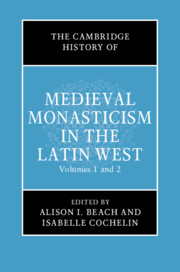Book contents
- The Cambridge History of Medieval Monasticism in the Latin WEST
- The New Cambridge History of Medieval Monasticism in the Latin West
- The Cambridge History of Medieval Monasticism in the Latin WEST
- Copyright page
- Contents
- Figures
- Contributors
- Acknowledgments
- Abbreviations
- 1 General Introduction
- Part I The Origins of Christian Monasticism to the Eighth Century
- Part II The Carolingians to the Eleventh Century
- Part III The Long Twelfth Century
- Part IV Forms of Monasticism in the Late Middle Ages
- 50 Late Medieval Monasticism: Historiography and Prospects
- 51 Sources of Late Medieval Monasticism
- 52 Monastic Liturgy, 1100–1500: Continuity and Performance
- 53 Books and Libraries within Monasteries
- 54 Art in Monastic Churches of Western Europe from the Twelfth to the Fourteenth Century
- 55 Lay Brothers and Sisters in the High and Late Middle Ages
- 56 Female Religious Life in the Twelfth and Thirteenth Centuries
- 57 Striving for Religious Perfection in the Lay World of Northern Europe
- 58 Monks and the Universities, c. 1200–1500
- 59 Bishops, Canon Law, and the Religious, c. 1140–1350
- 60 Daily Life in Late Medieval Monasteries
- 61 Monastic Preaching, c. 1350–1545
- 62 Research on Monasticism in the German Tradition
- 63 Satirical Depictions of Monastic Life
- 64 A Crisis of Late Medieval Monasticism?
- Index
- References
55 - Lay Brothers and Sisters in the High and Late Middle Ages
from Part IV - Forms of Monasticism in the Late Middle Ages
Published online by Cambridge University Press: 16 January 2020
- The Cambridge History of Medieval Monasticism in the Latin WEST
- The New Cambridge History of Medieval Monasticism in the Latin West
- The Cambridge History of Medieval Monasticism in the Latin WEST
- Copyright page
- Contents
- Figures
- Contributors
- Acknowledgments
- Abbreviations
- 1 General Introduction
- Part I The Origins of Christian Monasticism to the Eighth Century
- Part II The Carolingians to the Eleventh Century
- Part III The Long Twelfth Century
- Part IV Forms of Monasticism in the Late Middle Ages
- 50 Late Medieval Monasticism: Historiography and Prospects
- 51 Sources of Late Medieval Monasticism
- 52 Monastic Liturgy, 1100–1500: Continuity and Performance
- 53 Books and Libraries within Monasteries
- 54 Art in Monastic Churches of Western Europe from the Twelfth to the Fourteenth Century
- 55 Lay Brothers and Sisters in the High and Late Middle Ages
- 56 Female Religious Life in the Twelfth and Thirteenth Centuries
- 57 Striving for Religious Perfection in the Lay World of Northern Europe
- 58 Monks and the Universities, c. 1200–1500
- 59 Bishops, Canon Law, and the Religious, c. 1140–1350
- 60 Daily Life in Late Medieval Monasteries
- 61 Monastic Preaching, c. 1350–1545
- 62 Research on Monasticism in the German Tradition
- 63 Satirical Depictions of Monastic Life
- 64 A Crisis of Late Medieval Monasticism?
- Index
- References
Summary
Lay brothers and lay sisters—usually referred to as conversi and conversae—became a significant and very visible part of monastic life from the late eleventh century. The word conversus itself originally signified an adult convert to monastic life, as distinct from an oblatus, or child recruit to a monastery. But increasingly, the conversi and conversae of Western monasticism denoted a unique and sometimes quite multivalent status within an abbey or convent. Other Latin terms were sometimes used for these men and women, some of which are very general (such as laici, fratres, and sorores) and some of which denote difference on the basis of location (forinseci) or on the basis of physical appearance (barbati); a combination of these terms can also be used, such as fratres barbati. Confusingly for the modern historian of monasticism, some of these terms could occasionally also refer to men and women who were not lay brothers or lay sisters, but rather lay individuals or, in the case of fratres and sorores, monks and nuns.
- Type
- Chapter
- Information
- The Cambridge History of Medieval Monasticism in the Latin West , pp. 1027 - 1038Publisher: Cambridge University PressPrint publication year: 2020
References
- 1
- Cited by



